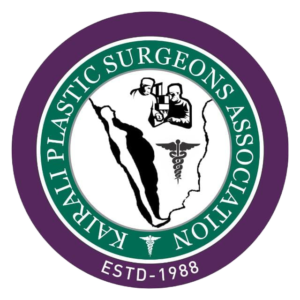
- Abdominal Wall Reconstruction
- Acute Trauma Management
- Breast Reconstruction
- Brachial Plexus and Peripheral Nerve Surgeries
- Burns And Reconstructive Surgeries
- Chest Wall Reconstruction
- Cleft And Craniofacial Surgeries
- Congenital Deformities
- Diabetic Foot & Its Management
- Gender Confirmation Surgeries
- Hand Surgeries
- Head & Neck Reconstruction
- Micro Vascular surgery
- Negative Pressure Wound Therapy
- Pressure Sore And Reconstructive Procedures
- Regenerative Medicine
- Tissue Expansion
INTRODUCTION:
Skin being the largest organ of our body, has multiple functions and in general protects the internal organs from environmental insults. Any breach in this protective layer endangers the stability and normal functioning of the body.
Most frequent cause of burns is scalds (spillage of hot liquids), followed by flame burns. Less frequent are contact burns, frictional burns, chemical burns, electrical injury, sun burns, lighting injury. While a number of them die due to burns per se & its multi organ complications, most survivors are left with disabilities & disfigurement making their life miserable. The treatment doesn’t limit to wound management and functional recovery, but extends to emotional, psycho-social and vocational rehabilitation over a course of months or years.
A realistic approach is necessary to harmonize patient expectations with probable outcomes of surgery.
MANAGEMENT OF ACUTE BURNS
The victim must be removed from the source of injury and the burning process stopped. Burning clothings should be removed along with watches, rings, jewellery or belts as all these items can retain heat. Inducing early cooling is the single most important factor in reducing the degree of burns and is best achieved by pouring of water over burn areas. In chemical burns, irrigation with copious amounts of water with care taken to prevent spread of chemicals to other areas is advised. Do not try to neutralize the chemicals as this leads to more heat production. Removal of victim from an electrical current is best done by turning off the electricity source and using a nonconductor to separate the victim from source.
How are these victims treated?
The victim must then be shifted to a hospital with burns care facilities. Upon arrival the victim is treated with adequate fluid resuscitation and oral feeds initiated as soon as possible. The goals of initial treatment are to stabilize the victim with stable vitals and adequate urine output (thus preventing kidney injury), adequate pain relief, initiation of oral intake, cleaning of the burn wounds and assessment of areas involved and the depth of burn wounds, providing temporary cover in the form of collagen dressings or ointment dressings
Once patient is stabilsed, further treatment depends on the depth of burn wounds. Superficial wounds heal well in 2-3 weeks by temporary biological covers like processed amniotic membrane or collagen dressings. Deep wounds require surgical removal of the dead skin and replacement with patients own skin taken from other body parts – a procedure called as Skin grafting. This is done nowadays as early as possible so as to prevent infection from these dead tissues. Infection leading to sepsis is the biggest challenge to burns victims once they circumvent the crucial initial period.
PROCEDURES:
EXCISION AND PRIMARY CLOSURE/ Z-PLASTY-
One of the simplest procedures of reconstruction. It is applicable in areas w here there is no deficiency of tissue that can be mobilized to close the wound. It involves excision of the whole scar tissue and adjacent tissue is mobilized for primary closure.
May also be done as serial excision, giving the surrounding tissue adequate to stretch. This is especially applicable in facial burns as it has the best outcome with good tissue texture and color match.CONTRACTURE RELEASE AND GRAFTING-
IIt involves excising the whole scar tissue and covering the tissue with a split or full thickness scar. It is, especially applicable over non-joint surfaces and where there is no sufficient tissue available for primary closure without compromising function.
SCAR EXCISION AND LOCAL FLAP COVER:
The whole scar tissue is excised as a whole and locally available skin and soft tissue is mobilized to cover the defect. The flaps have to be strategically designed to prevent further prominent scars or pull of surrounding appendages (especially in Head, neck and face region). Also important is planning the flaps to facilitate primary closure of donor sites and hence its use may be limited to small scars.
Advantages include best possible tissue texture and color match.FREE FLAPS:
The management of post burns scars and contractures have reached a milestone with the advent of microsurgery. Free tissue transfer offers a great option of large defects and joint contractures. Large area of scars especially over joint surfaces leading to contractures and difficulty in normal daily functioning, where there is inadequate or no locally available tissue.
The long term prognosis is good with vascular tissue.
The main limiting factors include- needs good microsurgical skills, longer hospital stay to assess flap vascularity, and availability of donor tissue in case of large surface burns and also morbidity of donor site.TISSUE EXPANSION:
In the face of limited availability of soft tissue cover, tissue expansion has revolutionized plastic surgery leaving the surgeon with far better prospects of reconstruction especially in burns sequelae management. While it provides skin with near perfect color and texture match, it also assures minimal donor site morbidity. The major limiting factors include cost of the implant per se and multiple procedures and serial expansion requiring the patient to come to the clinic or hospital multiple times.
NON-SURGICAL PROCEDURES:
- SPLINTS: splints are usually bulky and cumbersome. Patient compliance is a major decisive factor determining splint outcome. While minor contractures may require splinting alone, some may require surgical correction followed by splinting.
- FACE MASKS: for hypertrophied scars over the head, and face region with or without silicone inserts. Full time application of face masks may not be practical for most patients, however may be an option for patients who do not wish to undergo surgical procedures.
- SILICONE INSERTS:
RECOVERY:
Recovery from burns sequel and its management depends upon the procedure done. While primary excision and grafting or local flaps may be healed within a period of 2-3 weeks, free tissue transfer and major reconstructions require about 6weeks for full recovery. Most reconstructions, however ,require multiple procedures done at serial intervals of 6 months or more.
